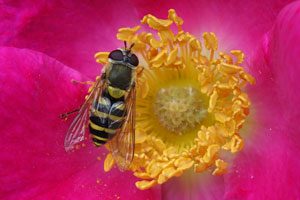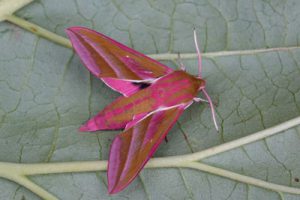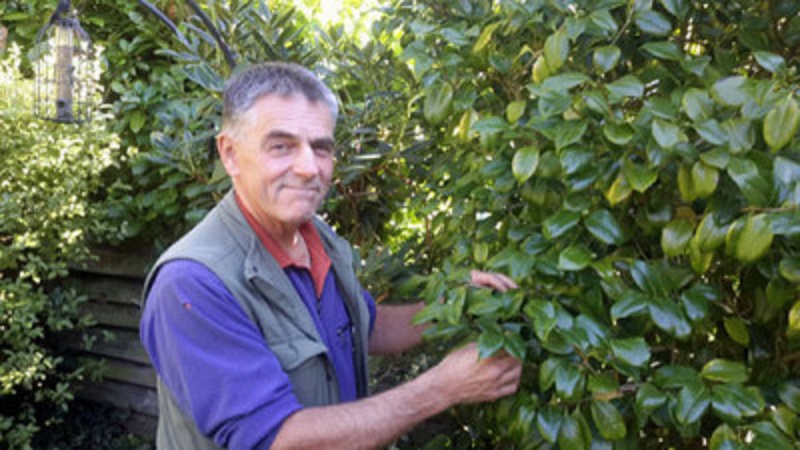How many of us, walking in the long grass, trample on the rare orchid nestling there, pass by tall trees without hearing or seeing the chiff chaffs feeding on insects getting ready for their flight to Africa, or, admiring the iris, fail to notice the larvae of a dragon fly clinging to its leaves. If, however, you are with Colin Page, your eyes and ears will be opened.
Standing in a garden with him is a lesson in observation. He is so in tune with the outdoor environment that he will instantly point out every insect, identify bird song and behaviour, and be able to name each unusual flower or tree. As a wildlife photographer and horticulturist he says : “Photography teaches you to notice things that other people may not see. You become programmed to look at things in a different way. I try to record the impact of light on whatever the subject might be”.
Colin is a true “Ryer”. His mother, born in Rye and was part of the Clark family who owned a bakers shop in the Mint. His grandfather, Edward Parlett, was a radio repairer who set up Rye Camera Club in 1956 and started taking pictures of the local area. “My grandfather and others in the group created a cine film of Romney Marsh about nesting swans which I remember watching at a Sunday School Christmas party and years later it turned up as a DVD at a local natural history society meeting”.
Colin inherited his grandfather’s love of photography and he has played an enormous part in encouraging others to develop the art. He joined the Rye Camera Club in 1978 and, after many years running the club as Chairman, he now remains a member.
“As a child my playground was the open habitat. I’d cycle to the beach, climb trees and play in the wooded banks which are now houses in Love Lane. A friend’s father, John Ashby, was a keen birdwatcher and we’d cycle to Rye Harbour and spend the afternoon identifying birds”. But most of his knowledge is self taught from guides bought with his pocket money and through hours of observation.
 With a library of over 50 illustrated nature talks and 200 slides for each talk piled high from floor to ceiling, Colin reluctantly decided it was time to go digital and he recently got rid of his film cameras. But his digital exploration stops there and he refuses to edit his photographs. “I try to get all I want at the time of making the image and use the camera to get the quality I’m looking for. I get out early or late when the light is at its best.
With a library of over 50 illustrated nature talks and 200 slides for each talk piled high from floor to ceiling, Colin reluctantly decided it was time to go digital and he recently got rid of his film cameras. But his digital exploration stops there and he refuses to edit his photographs. “I try to get all I want at the time of making the image and use the camera to get the quality I’m looking for. I get out early or late when the light is at its best.
For landscapes the early morning light is more effective for modelling and textures than when overhead. I can sit for two hours to get the right shot of a bee or wait for the larvae to emerge leaving the empty skin. Oh dear, people will think I have too much time on my hands but I don’t – the end result is worth the wait”.
After school and training, Colin and his wife Maureen worked at (and for a while ran) Harborough Nurseries in Icklesham but, after 44 years there, he is now happily self employed and offers natural history talks to local groups, advice on gardening (particularly wildlife gardening) and garden photography. He is a dedicated volunteer at the Sussex Wildlife Trust at Rye Harbour which he urges others to support and is also a volunteer for The Friends of Rye Harbour Nature Reserve.
Colin sometimes escapes to other beautiful parts of the world to explore and take photographs but to him Rye is unique. What people often don’t realise is that the visitors from all over the world that are attracted to Rye are not only the human variety. “The area is a magnet for wildlife: dragonflies from Scandinavia, European moths (see below), birds converge and pass through the area on migration. Certain conditions can arise which attract rare species. Geese from Iceland and Greenland arrive at Pett Level. Moths just two cms in size fly all the way from Africa. The promontory at Dungeness, far from being a barren wasteland, provides a resting point in the Channel for migrating birds”. 
If you would like to tune into nature, Colin’s next walk – Fungus Foray is on November 1 at Footlands Wood, Whatlington. He has also organised an event to be held at Rye Harbour Nature Reserve on March 19 where flautist Steven Preston, who gave a talk last year at the Rye Festival will be illustrating how birdsong has influenced composers. Details will soon be available at www.sussexwildlifetrust.org.uk/whats-on. Watch out too for his seasonal tips on his website at www.natureincolour.co.uk. And find more information at www.rxwildlife.info and https://sussexwildlifetrust.org.uk/visit/rye-harbour.
Main image Dee Alsey, other images by Colin Page



